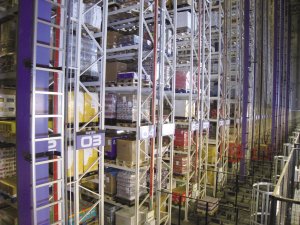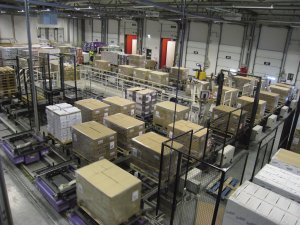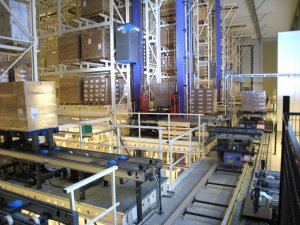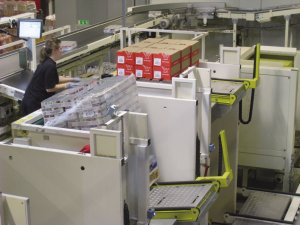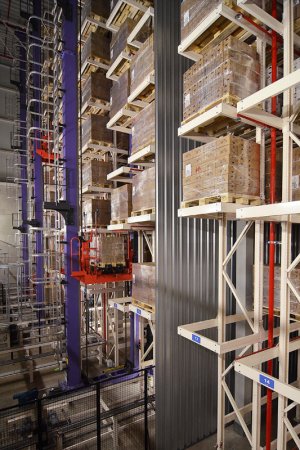Primary Problems Addressed:
- Floor space
- Need more space for production
- Productivity
- Limited capacity in storage and production areas
- Lack of responsiveness to product orders
- Inventory
- Poor product accessibility
- No real-time product tracking (WIP buildup)
- Ergonomics
- Workers in hostile environments
- Workers walking long distances
- Excessive noise levels from material handling equipment
- Safety hazards
- Labor-intensive processes
- Disjointed Operations
- Multiple staging areas
- Product is often moved from one staging area to another
- Many Non-Value Added operations
- Labor
- High employee turnover
- High labor costs
- Small labor pool
- Low job satisfaction
Separate input/output stations enable the STV to perform multiple tasks at one time. STVs are compact and move agilely over a track system, enabling higher throughput than conveyors. The STV track can be arranged in a loop or straight line to accommodate a variety of applications, such as mixed SKU pallet picking, cycle counting, quality inspection, load sorting and truck loading. Advantages of STVs include: fewer motors, no single point of failure, high-speed, high-throughput and expansion flexibility to handle future growth.
Daifuku's STVs are designed for seamless integration with mini load and unit load AS/RS to effectively transport raw materials, work-in-process and/or finished goods. STVs can also integrate with conveyor or ergonomic workstations to facilitate efficient order picking for consolidation and shipping.
Features
- High speed
- Close order traffic control
- Multiple layout options (multi-vehicle loop or single-vehicle shuttle)
- Variety of models (carton and pallet handling)
- Microprocessor control with RF (Radio Frequency) communication
- Expandable by adding vehicles
- Easy maintenance
- Quiet operation
- Sort loads to different delivery stations without complex conveyor intersections
- Accommodate a variety of building layout, space and performance requirements
- Bi-directional movement on single straight track for load pickup and delivery
- Modular layout simplifies system modification/expansion. Increase system capacity by simply adding vehicles
Benefits
- Improved inventory control
- Increased accuracy
- Increased throughput
- Eliminates of single-point failure; system can continue operating if a vehicle fails
- Enhanced product protection - smooth transport of items or goods
Specifications
The STV family includes product variations such as load handling (tote/box vs. pallet), layout (shuttle or loop), input/output/transfer mechanism (roller conveyor, chain conveyor, fork top) and number of vehicles. STV track can be arranged in a loop or straight line to accommodate a variety of uses such as mixed SKU pallet picking, cycle counting, quality inspections, load sorting and truck loading. STV's advantages over conveyor delivery systems include: fewer motors, no single point of failure, high speed, high throughput and flexibility to expand to handle future growth.
- Standard load weight capacity: 50-1,500 kg (110-3,300 lbs.)
- Standard horizontal speed: 100-200 m/min. (323-656 ft./min.)
- Standard transfer speed: 12-30 m/min. (39-98 ft./min.)
- Standard load footprint: 300-1500 mm x -350-1500 mm (11.8-59.1 in. x 13.8-59.1 in.)
Applicable Industries:
- Apparel
- Automotive
- Beauty & Cosmetics
- Book & Publication Distribution
- Electronics
- Food & Beverage
- Household Appliances
- Pharmaceuticals & Healthcare
- Retail
- Semiconductor
- Textiles







